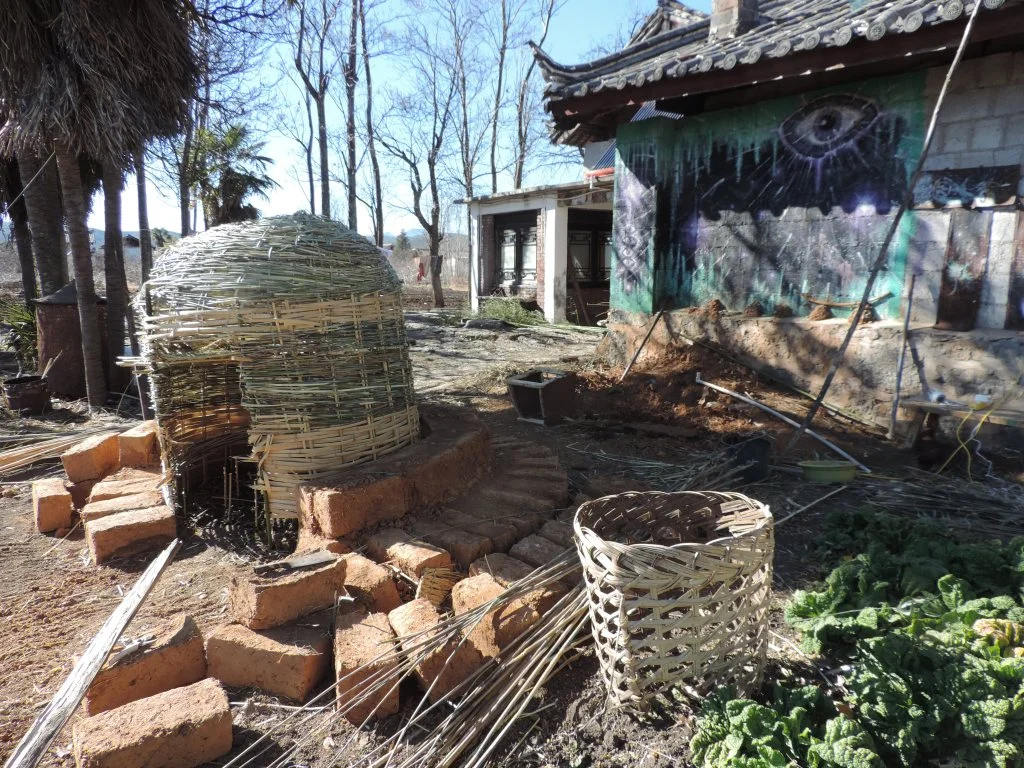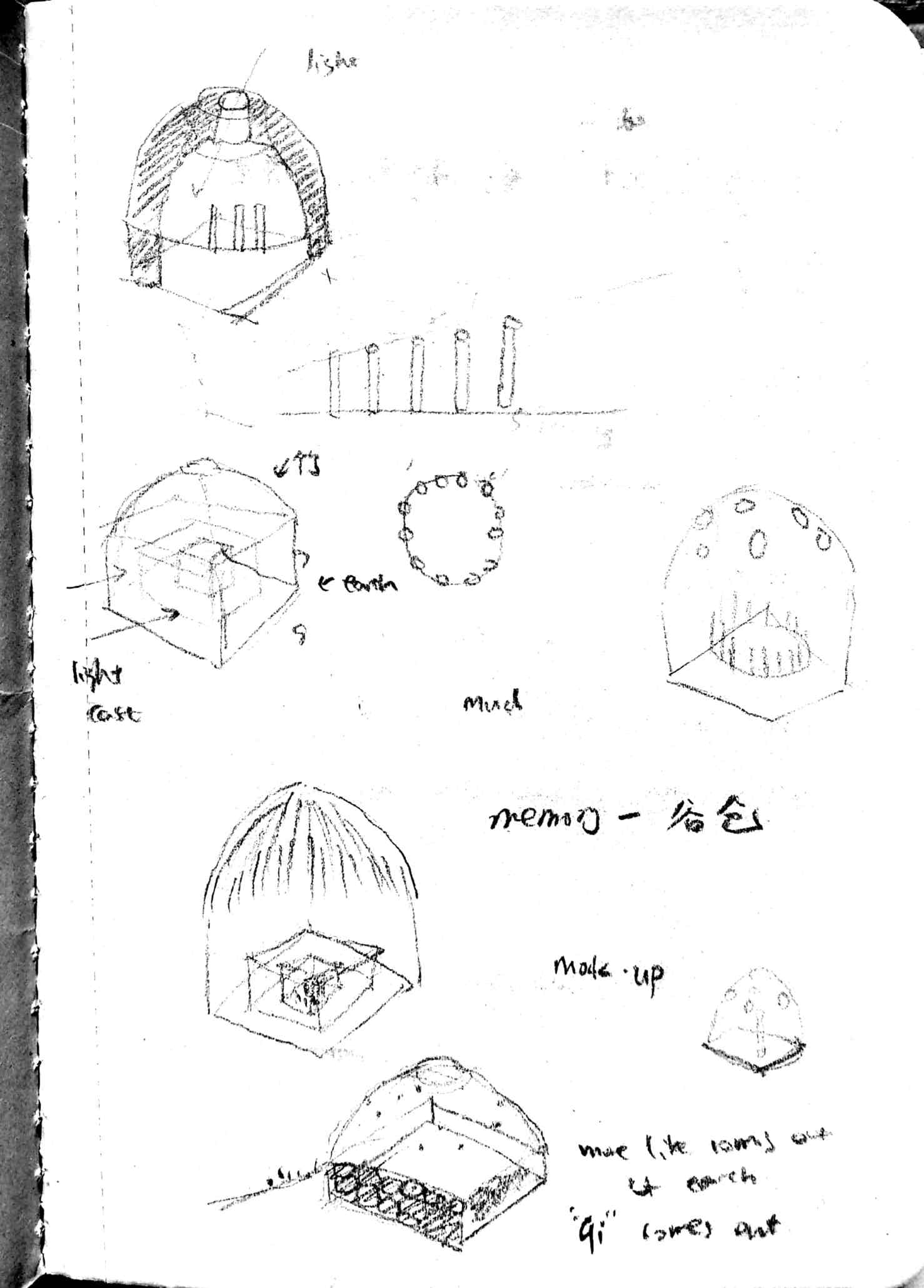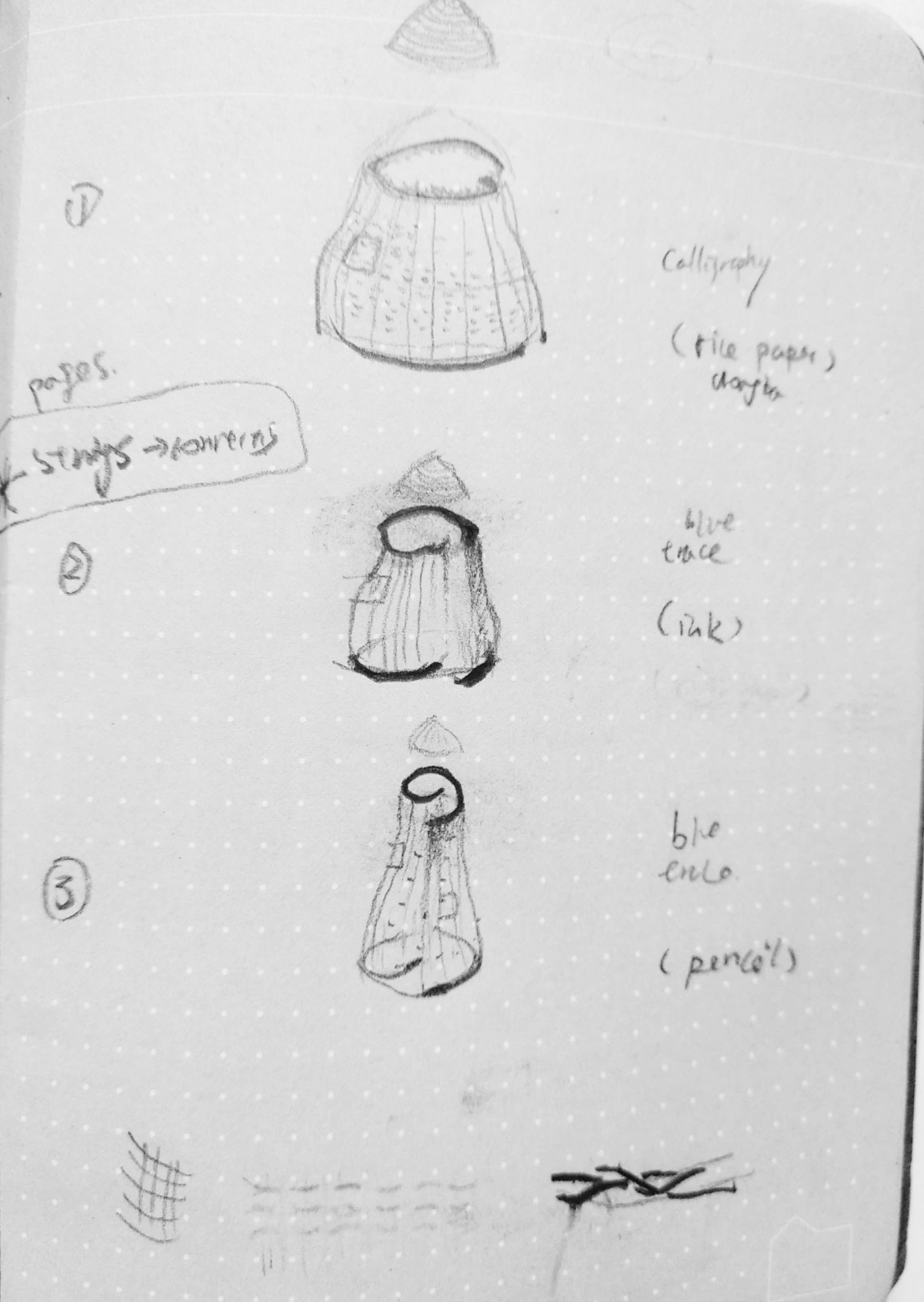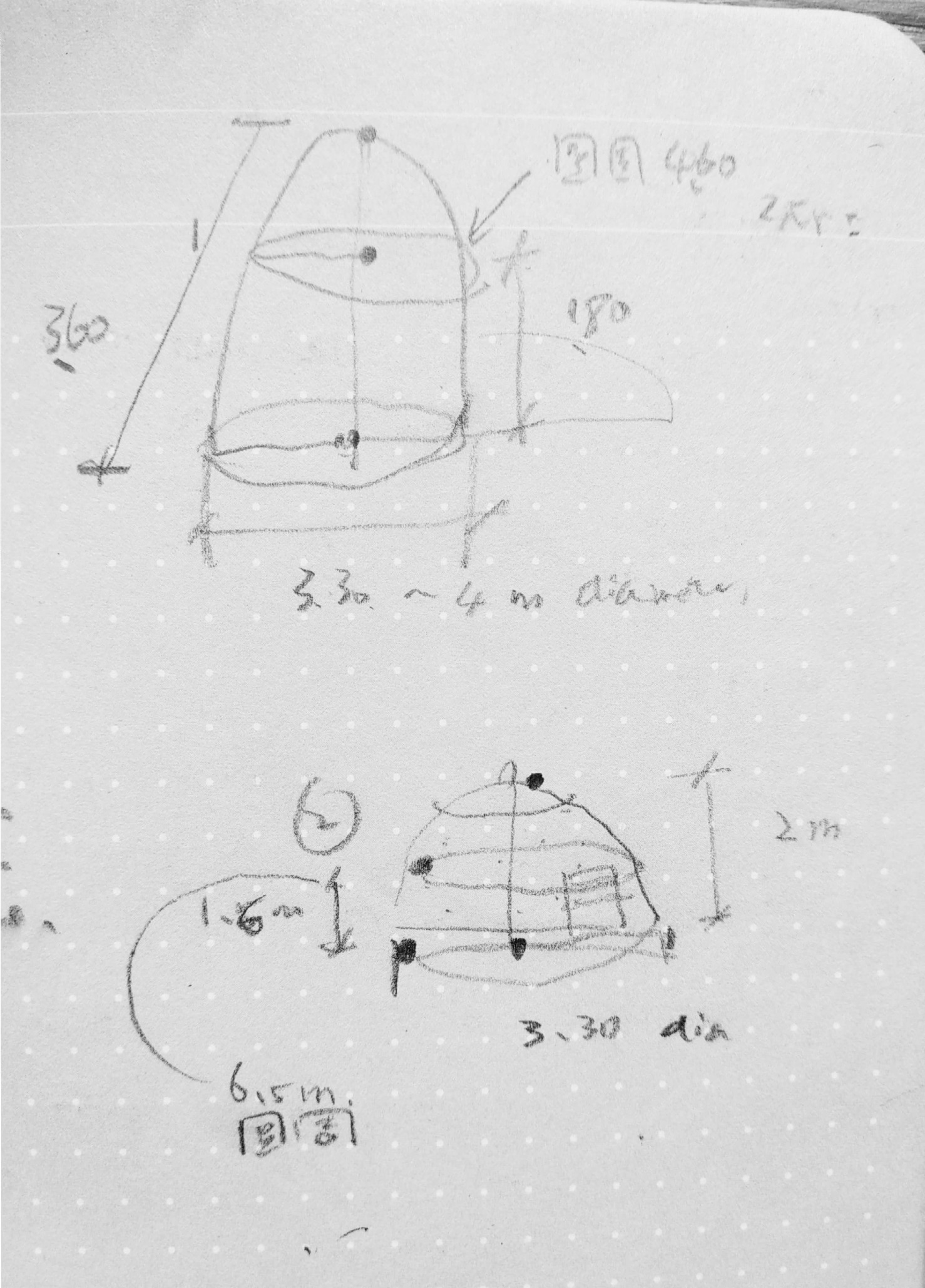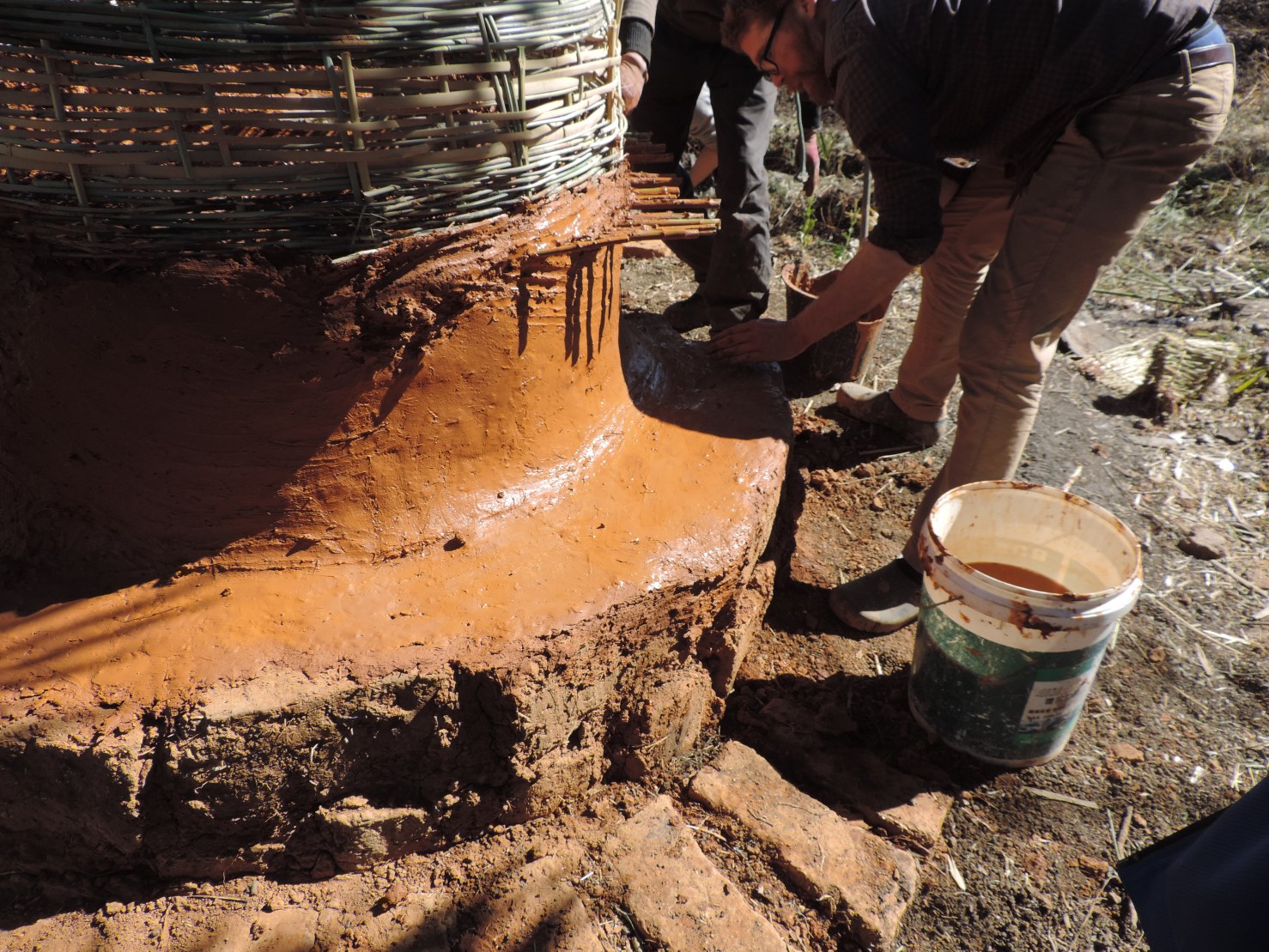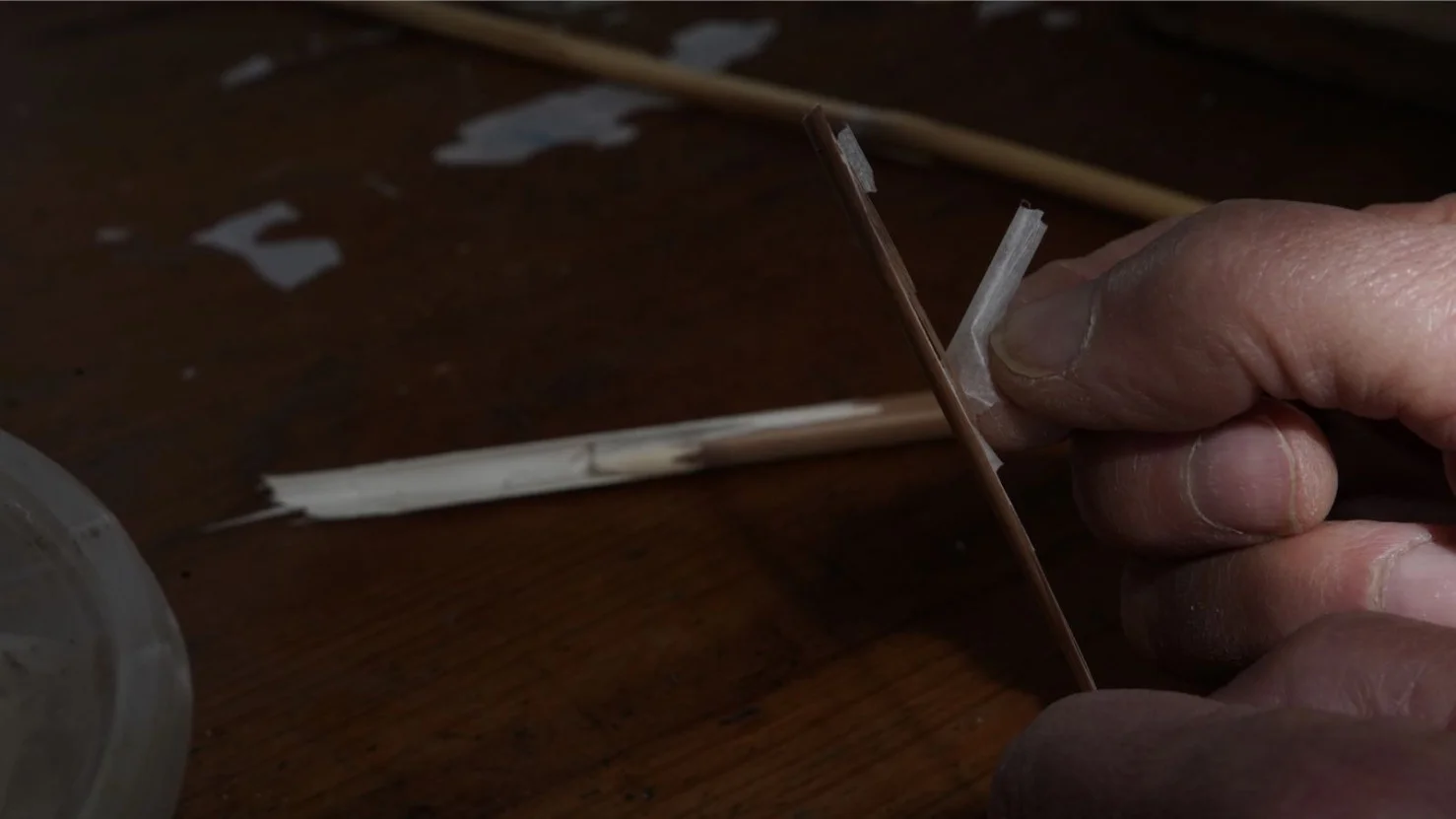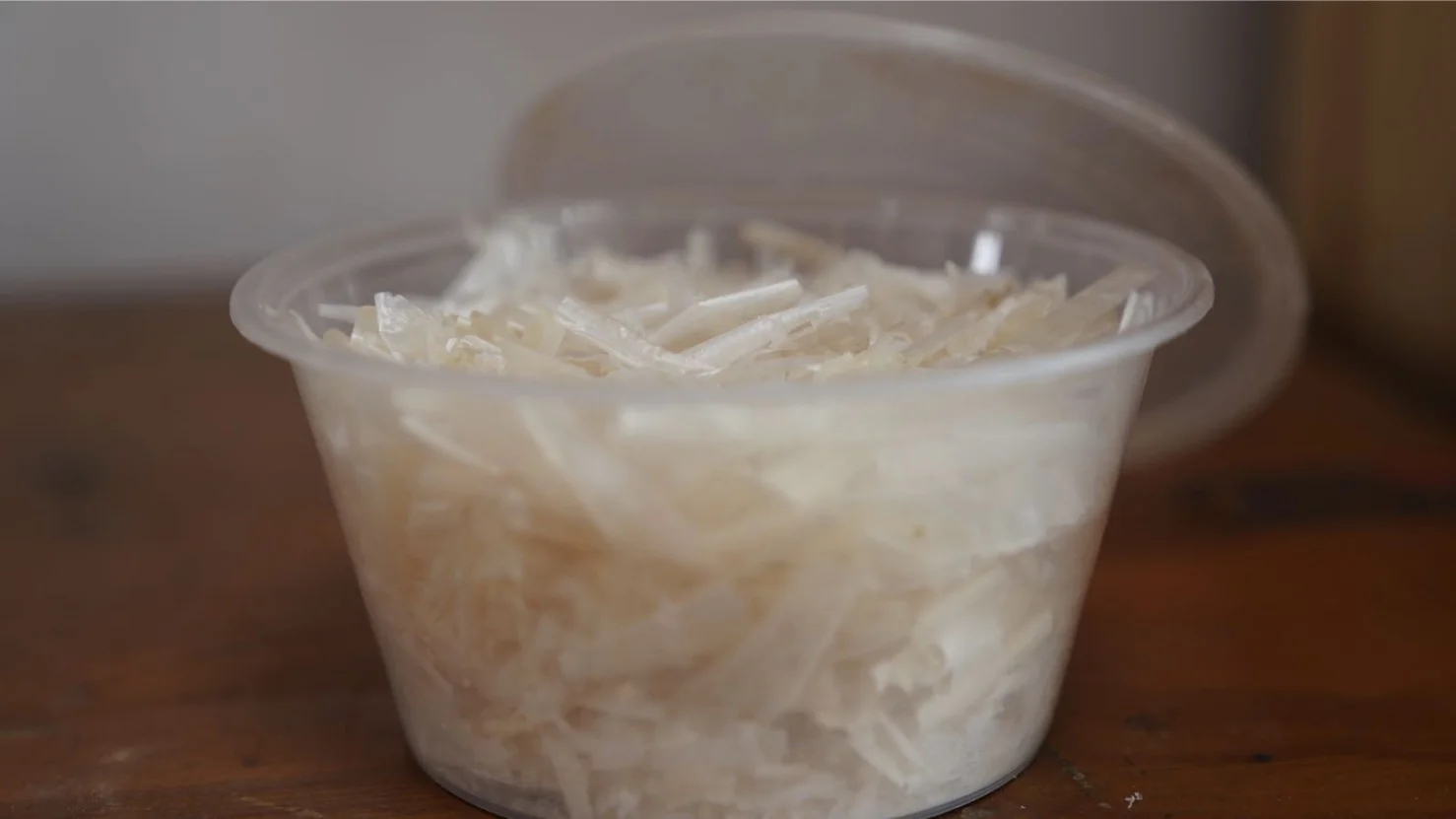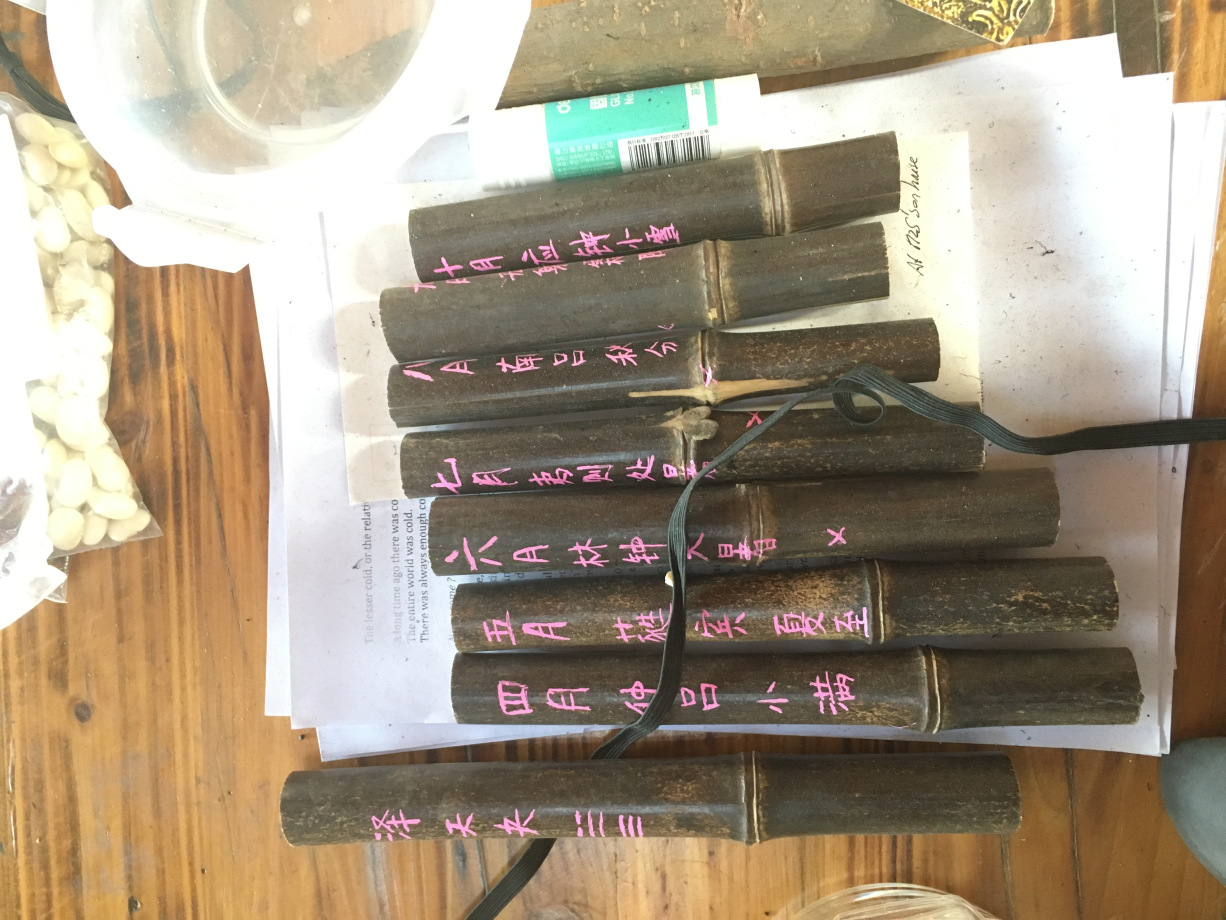Qi-mometer 候气室
This installation for visualising Qi is an attempt to re-imagine and reconstruct an ancient Chinese technology by professionals from different disciplines. The original Chinese name translates as ‘Waiting for Qi‘. The English translation “Qimometer” by Jay Brown highlights the complexities and limitations when exploring a system for interpreting life, that in the process of globalisation, has drawn any number of projections, from post-industrial religiosity (Raphael Lioger, 2009 quoted in Chenault, M. (2016) The Culture of Qi; books & ideas.net) to the esoteric. The English name makes no claims but draws in all humility attention to the measuring function of the installation.
在这次有关‘气’的视觉装置,不同领域的专业人士尝试重建或重新想象中国古的代技术。为了强调其中的复杂性与限度,Jay Brown将 “候气”翻译成“Qimometer”;这愈发国际化的世界,在系统化地解释生命时,引发了多理论,从后工业时期宗教主义(引用于Raphael Lioger, 2009;Chenault, M. (2016) The Culture of Qi; books & ideas.net)到其它深奥偏门的研究。Qimometer 这名字不做任何声明,却将注意力拉到这装置的衡量功能。
Not so dissimilar from modern soil thermometers, the purpose of the installation is to identify the most suitable time for planting seeds. But where the latter relies on a straightforward relationship between temperature and the soil’s capacity to germinate seeds, the Qimometer uses different media: the soil shows its readiness for germinating seeds by moving air with enough power to lift a layer of very fine ash off the ground and blow it upward through the dark narrow tunnel of a bamboo pipe several centimeters high. It announces the readiness of the soil to germinate seeds with an inaudible sigh, a scream, a tune, a song, a deep breath. One or the other? Or all at the same time? In any case, it makes visible temporal differences of a floating world.
此装置与现代土壤温度计没有太大区别,目的是确定最适合播种的时间。不同在于,后者依赖温度影响土壤发芽能力的直接关系,但前者所仰赖的机制则完全不同:土壤适合发芽的时候,气流会透过几厘米长的竹竿掀起地上的薄灰;恰似一种无声的叹息,尖叫,曲调,歌曲,深呼吸。。。是以上的一种,还是全部?就这样,它宣布土壤有能力使种子发芽的时候,让我们掌握无形的、捉摸不定的光阴世界。
Contents:
What you need to make a Qimometer
Building the Qimometer
Servicing the inner workings of the Qimometer
Podcast: Zhuming, He Jixing and Petra discuss their understandings of the description of this ancient technology.
Recording of the surveillance camera that monitors developments inside the installation.
What you need to make a Qimometer:
hought of ash puffing at an incalculable moment out of a bamboo pipe stuck in the ground
Vague instructions that leave a lot to the imagination (see below)
Land
An enthusiastic core team consisting of two artists of which one has local knowhow, a scientist and an architect.
A site identified by a local Feng Shui Master
Lots of time
Lots of help
Local Building Materials, in Jixiang Village these were:
a) 250 yuan worth of Mud Bricks, left over from the building of someone’s house
b) quartered, sun-dried valley bamboo;
c) freshly harvested mountain bamboo;
d) friends to help you locate, gather, transport and weave the bamboo
e) reeds and friends available in late autumn and winter to help you gather it
f) very patient people to harvest the membrane inside the reed stalks
g) a friendly pottery with a kiln
内容概括
1. 制造Qimometer的材料
2. 制造Qimometer
3. 维修Qimometer的内部机制
4. 音频:朱明、和吉星和Petra讨论他们对这一古老技术的理解
5. Qimometer内部监控装置所记录的视频
1. 建造Qimometer的材料:
• 想到薄灰从竹管内喷出时,能够同时保持兴奋与冷静
• 模糊又充满想象空间的指令(见下文)
• 土地
• 充满热情的核心团队,内附两位艺术家(其中一位必须要有当地知识)、一位科学家和一位建筑师
• 当地风水大师介绍的网站
• 大量的时间
• 大量的帮助
• 当地的建筑材料,在吉祥村即:
• a)泥砖(大概250元的量,可用别人盖房子剩下的材料)
• b)谷里伐的竹子(晒干,切成1/4段)
• c) 山上伐的竹子(新鲜)
• d)能帮找到、收集、运输和编织竹子的朋友
• e) 簧片(还有在深秋和冬季愿意伴你采集的朋友)
• f) 簧片茎膜(及非常有耐心的帮手)
• g) 友善的陶艺师傅(必须有自己的窑)
Based on the following guide, architect Wu Shuyin designed the installation.
建筑师舒吟根据以下指南,设计了整套装置。





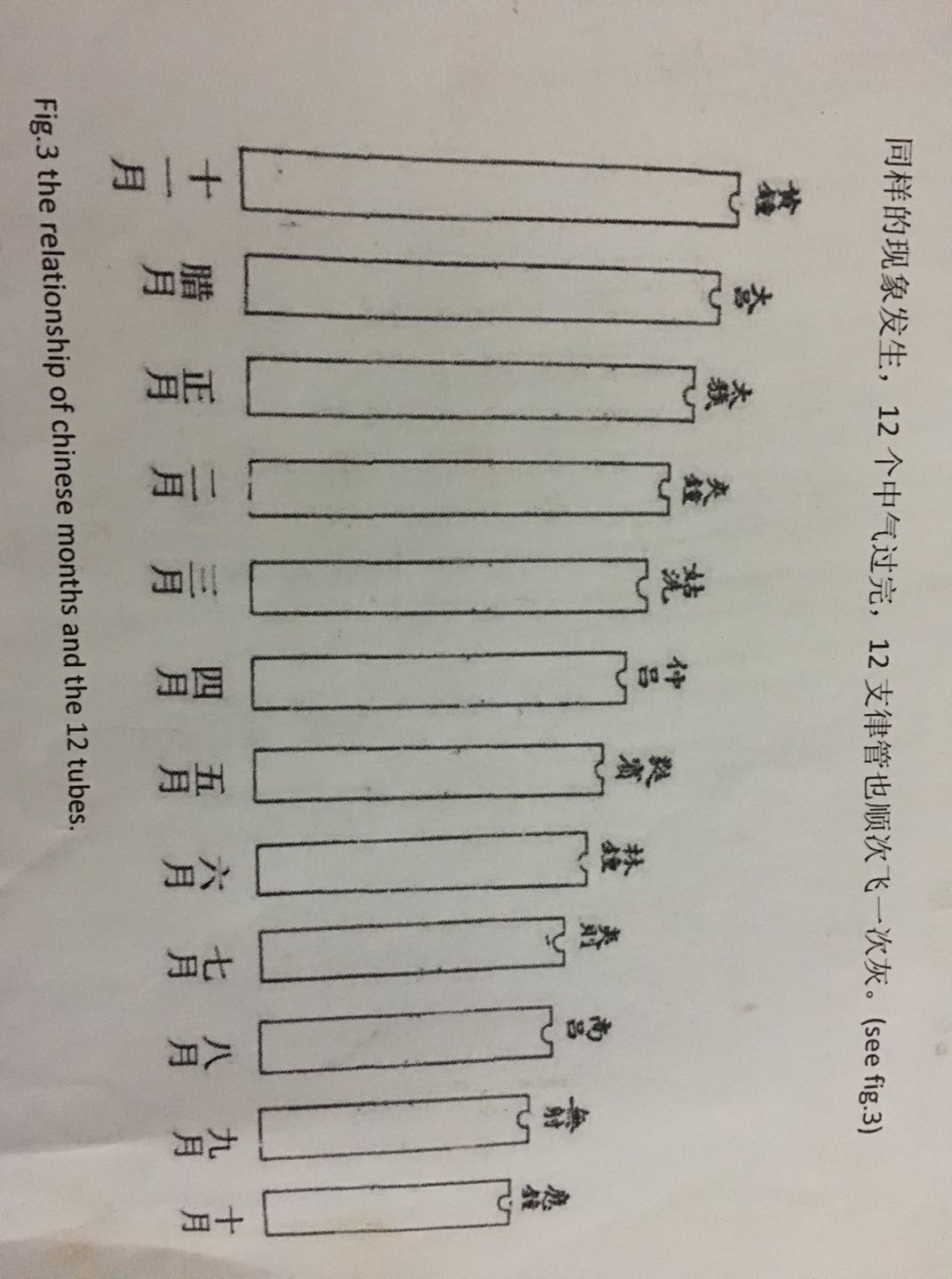
English translation:
According to historical records, the typical way to test for the change in seasons (候气) involves the following setup.
From outermost to innermost wall, the gates are south-facing, north-facing, and south-facing respectively. This maximally reduces the influence of external breezes, but a visitor must therefore approach the architecture like a maze to get to its heart. Any gaps in the wall must be filled tight, and the innermost walls and grounds are reinforced with a thick fabric (缇 ti) for further insulation. The room is named the ‘Ti’ room (缇室 tishi) after this specific fabric. (See Fig. 1.)
Occupying the interior mantle-room is a special set of twelve pipes composed of bamboo and metal. Here, the pipes are held upright, though in other historical periods they might be positioned obliquely on a desk. Their lengths vary between 9 and 4.5 inches, corresponding to the twelve-pitch scale of the traditional Chinese musical gamut. One might find this somewhat comparable a chromatic scale based on the standard common octave, forming the sequences: C, #C, D, #D, E, #E, F, G, #G, A, #A, B. (See Fig. 2.)
There are further customary specifications, such as aligning the pipes’ positions with the 12 time divisions or the 12 months. Finally, the pipes are filled with reed ash.
When the winter solstice arrives, air movements resulting from weather changes will break the reed membrane, puffing out the ash within. The same happens to the other pipes at corresponding times of the year (see Fig. 3.), and this is how the passing of the seasons is marked.
Fig. 3 The relationship of Chinese months and the 12 pipes.
(twelvetone equal temperament)
These two figures show the difference of the tune between earlier-time and later-time.
2. Building the Qimometer
In October 2018 we asked Mu Congpai, the local Qilin Master, to help us identify the best place for the installation. He chose the spot behind the kitchen next to one of the many vegetable plots Grandma tends. Mu Chongpei explained that from this spot, nothing obstructs the view toward the daily spectacle of the sun rising behind the mountains.
Beginning in October and continuing through January until early February 2019, Shuyin Wu (architect), He Zhiqin, (local weaver of fishnets and baskets), He Jixing (filmmaker), Zhu Ming (scholar) and Petra Johnson (artist) set off on what some of our closest and dearest friends considered an irrational quest.
2. 建造Qimometer
2018 年 10 月,我们请当地的风水大师 MuCongpai 帮我们挑选安装Qimometer的最佳地点。他选择了厨房后面的一个地方,旁边是奶奶照顾的菜地,解释道,这个地点没有阻挡日出的阻碍物,每天都会迎接太阳从山后升起的景观。
从10月到2019年2月初,舒吟(建筑师)、He Jixing(当地编织渔网和篮子的师傅)、和吉星(电影制片人)、朱明(学者)和Petra Johnson(艺术家)开始了一段让身边亲朋戚友咋舌的旅程。
Qimometer construction No. 1 by Wu Shuyin 2018-10-4
At first I conceived the Qimometer as a place, which humans can also inhabit, but Petra insisted that it is for the earth, not humans. I agree that it is a wonderful idea, to build something just for the earth. What will an instrument for the earth be like? From the conception of the Qimometer until its construction, it took 4 months. Below are the sketches that show the process.
Qimometer的建造(一),舒吟
2019年10月4日
我起初设想的Qimometer是供人居住的地方,但Petra坚持Qimometer属于地球而不是人类 — 给地球专门建造什么,这样的说法我觉得很美好。这应该是什么样的东西呢?Qimometer从构想到完成整整花了4个月,以下附带这过程的图案:
Qimometer construction No.2 by Wu Shuyin 2018-10-6
Local Fengshui master Mr. Mu identified the site for us. The following week layers of bricks are laid with Jixing and Zhuming. We also visited bamboo master, Mr. He, to learn how to slice and weave bamboo. Bamboo near the backyard is cut down for the structure of the Qimometer.
Qimometer的建造(二),舒吟
2018年10月6日
当地风水大师MuCongpai为我们确定了安置地点后,接下来的一周,吉星和朱明负责砌砖。我们还拜访了竹编师傅何先生,学习如何处理和编织竹子。我们将后院附近的竹子伐下,用来制作Qimometer 的架构。
Qimometer construction No.3 by Wu Shuyin 2018-10-19
How to weave the bamboo like a labyrinth and enclose the structure with wind proof material? The overall appearance should look like the haystacks, that can be seen everywhere in Jixiang village.
Qimometer的建造(三),舒吟
2018年10月 19日
如何将竹子编织得像迷宫一样,用防风材料包裹其结构?整体外观应该像吉祥村到处可见的干草堆。
Qimometer construction No.4 by Wu Shuyin 2018-10-20
The idea is to have a shell made of several layers to make sure that wind cannot enter the structure.
Qimometer的建造(四),舒吟
2018年10月20日
现在的想法是制造一个外壳,外壳有好几层,重点是要防止进风。
Qimometer construction No.5 by Wu Shuyin 2018-10-27
How to light the Qimometer from outside? Penetrations of light from the three layers of bamboo membranes are sketched and modeled in drawings. The drawings were then put into a box, made by local carpenter Mr. Yang, to let light filter through the three layers.
Qimometer的建造(五),舒吟
2018年10月27日
如何从外部照亮Qimometer?将光柱穿透竹膜三层结构的模样画在纸上当构图,然后,把这些图纸放入由当地木匠杨先生制作的盒子。 光线穿透三层竹膜。
2019 年 1 月,当我们正分秒必争地尝试完成安装时,寒冷的西风从附近大楼的拐角处吹来,严重考验我们的意志力。
By January 2019, as we are racing against time to complete the installation, a chilly West Wind rushes around the corner of the nearby building and sorely tests our persistence.
Qimometer construction No.6 by Wu Shuyin 2019-01-06
Arriving in Jixiang Village after two months away. The first thing to do is to visit the bamboo basket weaver Mr. He in the village. Three of us, Duskin, Zhu Ming and I become the bamboo master’s new apprentices. Duskin discovers that Master He uses a different bamboo than the one we have in our backyard. In Mr. He’s backyard, there is a bamboo called Mountain bamboo. It is more suitable for weaving. So we are off for a mountain trip to harvest bamboo in Jixing’s little truck.
Qimometer的建造(六),舒吟
2019年 1月6日
离别两个月后回到吉祥村,要做的第一件事就是去找竹编师傅何先生。Duskin,朱明和我成了何师傅的新学徒。Duskin发现,师傅用的竹子和我们后院的竹子不同。何师傅的后院藏了一种山上伐来的竹子,更适合编制工作。因此,我们乘坐吉兴的小卡车上山采竹去。
Qimometer construction No. 7 by Wu Shuyin 2019-01-07
In order to disguise the Qimometer as a haystack, Petra and I measure the dimensions of haystacks in the village, to get the right proportions.
Qimometer的建造(七),舒吟
2019年1月7日
为了让Qimometer造型恰似干草堆,Petra和我量了村子里干草堆的尺寸,取得正确的比例。
Qimometer construction No.8 by Wu Shuyin 2019-01-13
To be realistic regarding schedule and labour, I am now considering to make one simple basket with an opening toward the mountain. The basket is big enough so that one can sit inside and look at the distant mountain. Petra asks me to think of the construction in terms of the sun and the clouds looking in rather than anyone looking out. It is a beautiful idea.
Qimometer的建造(八),舒吟
2019年1月13日
为了要实际点,我现在考虑做一个简单的篮子,将其开口朝向山。篮子够大,可以坐在里面遥望远处的山;但Petra提议我换个角度思考,把它想成是太阳和云层往进篮子里来。这想法的确很诗意。
Qimometer construction No.9 by Wu Shuyin 2019-01-26
The last sketches to be drawn, a simple basket, a container for the earth’s energy. We finish the Qimometer before Chinese New Year.
Qimometer的建造(九),舒吟
2019年1月26日
最后一张草图,一个简单的篮子,一个装载地球能量的容器。春节之前,我们完成了Qimometer。
We would not have been able to maintain our momentum without the generous help from: Katika Mediani, (animation artist); Jay Brown (founder and host of the Lijiang Studio); Duskin Drum (artist and educator); He Zhenjin, (local basketmaker); Bochay Drum (landscape archaeologist); Ben Torpey (farmer); Xu Zhifeng (architect/artist); He Erge and He Xuemei, who found locations where we could gather suitable mountain bamboo and a group of high school students from the US who helped rain-proof the woven structure with mud and helped build a path to it.
如果没有以下的人慷慨帮助,我们就无法维持势头:Katika Mediani(动画艺术家); Jay Brown(丽江工作室创始人兼东主);Duskin Drum(艺术家兼教育家); He Zhenjin(当地编制师傅);Bochay Drum(景观考古学家);Ben Torpey(农夫);许志锋(建筑师兼艺术家);感谢和雪梅和和恒光找到山上可以采集竹子的地方,以及一群美国高中生用泥浆为编织出的结构进行防水功夫,并建造一条通往它的小路。
3. Servicing the inner workings of the Qimometer
In the week of Spring Equinox (from 21 March 2019 onwards), we collected our second batch of ash. The ash is made of reed membrane fired at 800 centigrade in a kiln at a pottery in Ciman Village. Zhu Ming crushes the flakes of ash into a powder. Every one of the processes required to get to the ash, reduces volume by a breathtaking degree, at least it is breathtaking if you are the one who gathered the reeds and who peeled the membrane out of the stalks. It takes a minimum of five half days to fill a pot, like the one below. It is a very slow and delicate process. Once ground to a powder the ash is transferred into the bamboo pipe.
3. 维修气功仪的内部工作
在春分周(2019年3月21日起),我们收集了第二批灰。灰是用簧片在茨满村的一个窑中以800摄氏度的高温烧制的。朱明把焦灰了的簧片压成粉末;几乎每个步骤都以惊人的程度减少最终所取得的灰。尤其是对收集簧片,将薄膜从茎中取出的人,因为装满一小容器(如图所示)的量就需要至少五天半的时间。这是一个非常缓慢和精细的过程。一旦将灰片磨成粉末,就能把粉末送入竹管。
Peeling Membrane
剥茎取膜
Five afternoons of peeling fill this box measuring 15cm radius x 7.5cm depth.
五个下午的功夫,竟只能填满这半径15厘米宽 7.5厘米深的容器。
Crushing the ash of reed membrane into powder
将簧片膜的灰烬捣成粉末
Eight of twelve prepared bamboo pipes ready to join the already installed four pipes in the Qimometer
十二根竹管中的八根,准备加入已经安装在Qimometer中的四根管子
4. Podcast: ‘Ideas are eternal constellations. In the process of rescuing them, the elements of such constellations are grasped and phenomena reveal themselves as pointers.’ Walter Benjamin (1925), Der Ursprung des deutschen Trauerspiels (Play of Mourning), Preface available on https://www.textlog.de/benjamin-idee-konfiguration-ursprung-trauerspiels.html; translation by Howard Eiland (2019) in The Origin of the German Trauerspiel, Harvard University Press.
4. 播客:'思想是永恒的星座。在拯救它们的过程中,我们参悟这些星座的奥秘,将其天象解读成指引方向的指南。Walter Benjamin(1925年),《Der Ursprung des deutschen Trauerspiels (Play of Mourning)》,前言,https://www.textlog.de/benjamin-idee-konfiguration-ursprung-trauerspiels.html;
Howard Eiland(2019年)在《德国特劳尔斯皮尔的起源》一文中翻译,哈佛大学出版社。
17/04/2019 与朱明、Petra和和吉星讨论Qimometer、地球能量和地球是乐器的命题
5. Recordings of the surveillance camera that monitors developments inside the installation.
5.内部监控摄像机所录下的视频:
https://youtu.be/u6PDLx9ZZEQ
一个访客!感谢许志锋安装的摄像机,让我们可以随时随地观看内部运作。
A visitor! We can watch the interior workings from anywhere and at any time thanks to a camera installed by Xu Zhifeng.

